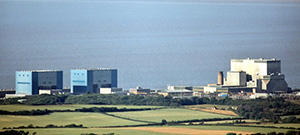Earthquake experiments extend safe operation of UK nuclear power stations
Work by a team at the Faculty of Engineering has proved that reactors in the UK can be shut down safely after seismic events and has helped EDF Energy safeguard the generation of over £4bn of low carbon electricity that would have otherwise been lost.
Advanced Gas-cooled Reactors (AGRs) in the UK nuclear power stations are subject to expected radiation-driven ageing that leads to cracking in the reactor core.
The challenge for operator, EDF Energy, is that it must demonstrate that this does not affect the safe shutdown of a reactor in the event of an earthquake. The problem is that physical testing of a core is impossible – making it difficult for EDF to prove to industry regulators that older AGRs can continue to operate safely and generate low carbon electricity much needed by the UK economy. Thanks to research at Bristol that problem has now been solved.
Physical scale modelling provides the solution
Cracking in AGRs increases the dynamic flexibility of the graphite core which in turn affects its seismic response. Crucially, excessive distortions can prevent insertion of the control rods needed to shut down reactors in an emergency – and with physical testing of a real core not possible, physical scale modelling is the only empirically valid way to assess whether a shutdown can take place or not.
The University’s seven-year £6.95 million research programme has focused on making this modelling approach a workable reality by collaborating with EDF. The team also worked with Atkins, a global engineering consultancy that has developed a numerical model known as GCORE that can assess the seismic safety of a reactor when subjected to a 1-in-10,000-year UK earthquake (equivalent to about a Magnitude 6.2 event on the Richter scale).
 The team at Bristol achieved a critical breakthrough for this collective by developing an innovative, high precision quarter-scale physical model of a representative AGR graphite core assembly that can accommodate a wide range of structurally degraded core configurations. The model is made from Acetal plastic and can be shaken on a six-axis earthquake simulator (or shaking table) in the University’s engineering laboratories.
The team at Bristol achieved a critical breakthrough for this collective by developing an innovative, high precision quarter-scale physical model of a representative AGR graphite core assembly that can accommodate a wide range of structurally degraded core configurations. The model is made from Acetal plastic and can be shaken on a six-axis earthquake simulator (or shaking table) in the University’s engineering laboratories.
The bespoke physical model contains over 40,000 components and 3,200 sensors in a package measuring approximately 2.5 x 2.5 x 2.0m and weighing 8 tonnes. The rig development also involved the integration of high precision structural engineering and manufacturing, innovative electronic sensor development, and cutting-edge data analysis and experimental techniques.
Overall, the experiments shook 12 model cores with hundreds of simulated earthquakes, producing around 20 terabytes of data that EDF and Atkins have used to reveal important insights into an aged graphite core's seismic behaviour and integrity and to show that the GCORE computer model results are in close agreement with the physical model.
Extended safe-life safeguards electricity supply
Without this research, none of the 14 AGRs that contributed 14% of the UK’s electricity supply could be operated beyond the onset of cracking in their graphite cores. The results of the experiments enabled EDF to present successful seismic safety cases to the Office for Nuclear Regulation, resulting in safe-life extensions of the eight oldest reactors and the preservation of the generation of over £4bn of low carbon electricity that otherwise would have been lost.
 Confidence in closure dates with these extensions is crucial for EDF’s long-term business and financial planning. It is also important to the UK government and its planning for the security and renewal of the UK’s future low-carbon electricity supply capacity.
Confidence in closure dates with these extensions is crucial for EDF’s long-term business and financial planning. It is also important to the UK government and its planning for the security and renewal of the UK’s future low-carbon electricity supply capacity.
There have been further significant benefits for EDF’s consulting partner Atkins, which has been able to improve and validate its GCORE modelling capability and strengthen its business relationship with EDF. In the future, Atkins will also be able to use the insight it has gained into state-of-the-art seismic testing to widen the range of options it can offer for other seismic analyses.
 Work with us
Work with us
Our Industrial Liaison Office helps you to develop research partnerships.
Quick facts
- Experiments underpin proof that safe shut down of reactors possible after 1 in 10,000 year earthquake
- Approval by Office for Nuclear Regulation safeguards production of over £4bn of low carbon electricity
- Significant business benefits for EDF and its engineering consulting partner Atkins
